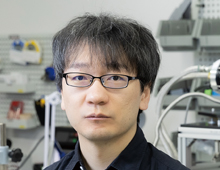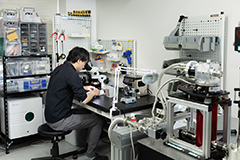Emergent Quantum Spintronics Research Unit
Principal Investigator
- PI Name
- Tomoyuki Yokouchi
- Title
- Unit Leader
- Brief Resume
2018 D. Eng., The University of Tokyo 2018 Special Postdoctoral Researcher, RIKEN Center for Emergent Matter Science 2020 Assistant Professor, Graduate School of Arts and Sciences, The University of Tokyo 2023 Unit Leader, Emergent Quantum Spintronics Research Unit, Cross-Divisional Materials Research Program, RIKEN Center for Emergent Matter Science (-present)

Outline

The aim of our unit is to understand the quantum and emergent properties in spintronics, which aims to utilize both the charge and spin of electrons, and to construct a new scheme for them. In particular, by employing microfabrication techniques, we will develop novel quantum spintronic and quantum transport phenomena in various magnetic materials. Our goal is to elucidate the mechanisms driving their emergence. Furthermore, by focusing on the classical and quantum dynamics of topological spin structures, we will also work to establish a new scheme for emergent computational techniques, such as physical reservoir computing.
Research Fields
Physics, Engineering, Materials Sciences, Computer Science, Multidisciplinary
Keywords
Spintronics
Artificial intelligence
Magnetic skyrmions
Spin dynamics
Spin Hall effect
Results
Physical reservoir computing using skyrmions
Recently, artificial intelligence (AI), which is machine learning inspired by the design of the human brain, has been rapidly developing, leading to innovative technologies and services. However, addressing the substantial power consumption when executing AI with conventional computational devices has become an urgent issue. Consequently, the study of “neuromorphic devices”, which mimic the brain’s behavior at the device level aiming for higher performance and energy-efficient artificial intelligence, has become crucial.
We have demonstrated that a topological spin structure called a skyrmion can be used for “physical reservoir computing”, a category of neuromorphic devices. First, we revealed that the skyrmion dynamics induced by a magnetic field satisfy the properties required for physical reservoir computing. Then, by fabricating skyrmion-based physical reservoir devices and conducting several benchmark tests, we found that the formation of skyrmions is vital for improving the performance. This discovery reveals the potential to improve the performance and energy efficiency of neuromorphic devices using skyrmions.

Schematics of the benchmark test for the skyrmion physical reservoir. (a) Waveform of the input signal. For the benchmark test, we input a combination of sine waves and square waves, and executed a problem that outputs 1 if the input is a sine wave and -1 if it is a square wave. (b) Schematic of the skyrmion physical reservoir device. The skyrmion physical reservoir device was constructed by connecting cross-shape devices in parallel. (c) Output waveforms from each cross-shape device. (d) Final output of the skyrmion physical reservoir computer. The red and blue horizontal lines indicate the correct output.
Members
Tomoyuki Yokouchi |
Unit Leader | tomoyuki.yokouchi[at]riken.jp | |
|---|---|---|---|
Hikaru Fukuda |
Special Postdoctoral Researcher | ||
Yunyoung Hwang |
Postdoctoral Researcher |
Publications
- T. Yokouchi, Y. Ikeda, T. Morimoto, and Y. Shiomi,
Phys. Rev. Lett. 130, 136301 (2023)Giant Magnetochiral Anisotropy in Weyl-semimetal WTe2 Induced by Diverging Berry Curvature
- T. Yokouchi, S. Sugimoto, B. Rana, S. Seki, N. Ogawa, Y. Shiomi, S. Kasai, and Y. Otani
Sci. Adv. 8, eabq5652 (2022)Pattern recognition with neuromorphic computing using magnetic field-induced dynamics of skyrmions
- T. Yokouchi, F. Kagawa, M. Hirschberger, Y. Otani, N. Nagaosa, and Y. Tokura
Nature 586, 232 (2020)Emergent electromagnetic induction in a helical-spin magnet
- T. Yokouchi, S. Sugimoto, B. Rana, S. Seki, N. Ogawa, S. Kasai, and Y. Otani
Nat. Nanotechnol. 15, 361 (2020)Creation of magnetic skyrmions by surface acoustic waves
- T. Yokouchi, S. Hoshino, N. Kanazawa, A. Kikkawa, D. Morikawa, K. Shibata, T.-h. Arima, Y. Taguchi, F. Kagawa, N. Nagaosa, and Y. Tokura
Sci. Adv. 4, aat1115 (2018)Current-induced dynamics of skyrmion strings
- T. Yokouchi, N. Kanazawa, A. Kikkawa, D. Morikawa, K. Shibata, T. Arima, Y. Taguchi, F. Kagawa, and Y. Tokura
Nat. Commun. 8, 866 (2017)Electrical magnetochiral effect induced by chiral spin fluctuations
Contact Us
2-1 Hirosawa, Wako, Saitama 351-0198 Japan
TEL:+81-(0)50-3500-6478
E-mail:
tomoyuki.yokouchi[at]riken.jp
